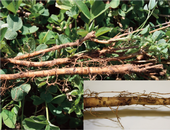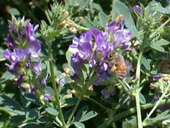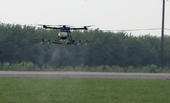- (Public Value) UCANR: Promoting economic prosperity in California
- Author: Michelle Leinfelder-Miles
- Author: Rachael Long
- Author: Rob Wilson
- Author: Ian Grettenberger

I have received a couple calls this year from growers and a PCA about root scarring in alfalfa fields. These observations were a bit of a “head scratcher” for all of us. At one of the fields, I noticed what looked to be a wireworm on the root, so that was throwing me off (Figure 1). Cutworms can also feed on plant roots. The larger instars have been found below the crowns under plant debris, but we didn't find any at this site. I reached out to Farm Advisor Rachael Long to get her thoughts. I had once heard Rachael talk about clover root curculio, and I wondered if it was causing the problem. While we have not confirmed that clover root curculio is present and causing damage in...
- Author: Rachael Freeman Long
- Author: Morgan Doran
- Author: Brooke Latack
- Author: Richard Zinn
- View More...

A question came up from a rancher/farmer about grazing alfalfa seed production fields after seed harvest. Can one safely turn livestock onto alfalfa seed fields or cut and bale the hay for feed after harvesting the seed?
Yes, with the following considerations:
1) Watch for Chemical Residues. Some of the currently registered chemicals used in alfalfa seed production for pest control and desiccation restrict treated plant material from entering the food chain. Be sure to read the pesticide label before allowing livestock to graze or feed on alfalfa hay after a seed crop harvest. For example, alfalfa treated with Reglone, a diquat based...
- Author: Rachael Freeman Long
- Author: Dr. Ken Giles
- Author: Dr. Xuan Li
- Author: Bill Reynolds

Use of drones (UAV, unmanned aerial vehicle) for aerial application of pesticides in agricultural crops is becoming a reality.
Drone technology provides an additional tool for growers to control pests and diseases on farms, supplementing traditional ground and aerial spraying practices. This could be especially helpful in areas where there's a shortage of farm labor for pesticide applications or for small areas that require spot treatment.
2020 Drone Trials
In the summer 2020, we evaluated the efficacy of drones compared to airplanes for applying insecticides for summer worm control in alfalfa hay fields (see Photo 1). These pests can be highly damaging to alfalfa as the larvae...
- Author: Ian Grettenberger
- Author: Rachael Long
- Author: Daniel H Putnam
- Author: Rob Wilson

"The enemy of my enemy is my friend" holds true in entomology as well!
The activity of natural enemies of pests (beneficial insects) is a key component of Integrated Pest Management in alfalfa to prevent pest resurgence and secondary pest outbreaks.
This is especially true for blue alfalfa aphid (BAA), a challenging pest in alfalfa (see companion article on managing BAA). Although BAA is frequently the most damaging and troublesome aphid to control, spotted alfalfa aphid, pea aphid, and cowpea aphid can also be problematic.
In alfalfa, aphids have many natural enemies. Some, like lady beetles, syrphid...



